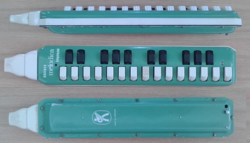Melodica
 Hohner melodica | |
| Keyboard instrument | |
|---|---|
| Classification | Wind; free reed aerophone |
| Hornbostel–Sachs classification | 412.132 (Free-reed aerophone) |
| Developed | 1950s |
| Playing range | |
| Usually 2 or 3 octaves | |
| Related instruments | |
| accordion, harmonica, pump organ, yu | |
The melodica is a free-reed instrument similar to the pump organ and harmonica. It has a musical keyboard on top, and is played by blowing air through a mouthpiece that fits into a hole in the side of the instrument. Pressing a key opens a hole, allowing air to flow through a reed. The keyboard usually covers two or three octaves. Melodicas are small, light, and portable. They are popular in music education, especially in Asia.
The modern form of the instrument was invented by Hohner in the 1950s,[1] though similar instruments have been known in Italy since the 19th century.[2]
Use[]
The melodica was first used as a serious musical instrument in the 1960s by composers such as Steve Reich, in his piece titled Melodica (1966).[3] Brazilian multi-instrumentalist Hermeto Pascoal developed a technique consisting of singing while playing the melodica, resulting in a wide tonal and harmonic palette.[4] It is associated with Jamaican dub and reggae musician Augustus Pablo who popularized it in the 1970s,[5] and more recently with Jon Batiste, who is often seen playing the instrument on The Late Show with Stephen Colbert.
Types[]

Melodicas are classified primarily by the range of the instrument. Melodicas with different ranges have slightly different shapes.
- Soprano and alto melodicas are higher-pitched and thinner sounding than tenors. Some are designed to be played with both hands at once: the left hand plays the black keys, and the right hand plays the white keys. Others are played like the tenor melodica.
- Tenor melodicas are a lower-pitched type of melodica. The left hand holds a handle on the bottom, and the right hand plays the keyboard. Tenor melodicas can be played with two hands by inserting a tube into the mouthpiece hole and placing the melodica on a flat surface.
- Bass melodicas also exist.
- The Accordina aka 'Chromatic Button Melodica', generally made of metal, uses the same mechanism and reeds as a traditional melodica. The keyboard is replaced with a button arrangement similar to a chromatic button accordion's keyboard.
Wooden melodicas[]
Although the majority of melodicas are made of plastic, some are made primarily of wood. Daren Banarsë makes melodicas with a combination of 3D printing, woodwork, and high-quality Italian reeds. These reeds respond better to airflow, stay in tune longer, and allow a more balanced dynamic within chords.[6] His wooden instruments are “professional-looking” and “backed up by a high, crisp tone similar to that of an accordion” [7] The Sound Electra corporation makes the MyLodica, a wooden melodica designed "...to produce a warmer richer sound than that of its plastic relatives."[8] The Victoria Accordion company in Castelfidardo, Italy, produces a range of wooden melodicas and accordinas that they market under the name Vibrandoneon.

Alternative names[]
The melodica is known by various names, often at the whim of the manufacturer. Melodion (Suzuki), Triola (Seydel), Melodika (Apollo), Melodia (Diana), Pianica (Yamaha), Melodihorn (Samick), Diamonica (Bontempi), Pianetta (Guerrini), face piano, and Clavietta (Borel/Beuscher) are just some of the variants. When a recording technician unfamiliar with the melodica called it a "hooter", the band The Hooters took that as their name.[9]

Two hands[]


Melodica can be played with two hands employing an air tube. To blow air, a foot pump can also be used.[10][11][12]
Gallery[]

A Suzuki melodion

Hohner alto melodica

Melodica being played vertically, without air tube

Patent drawing for accordina
Accordina being played

Donald Fagen with a Yamaha Pianica in 2007
See also[]
References[]
- ^ Missin P (2004). "A Brief History of Mouth-Blown Free Reed Instruments: Melodica Family". Archived from the original on 2013-09-26. Retrieved 2013-07-03.
- ^ "Vibrandoneon". Duskyrecords.nl. Archived from the original on 2016-08-22. Retrieved 2013-07-03.
- ^ "Steve Reich – Melodica". Boosey & Hawkes. 1966-05-22. Retrieved 2013-07-03.
- ^ Hermeto Pascoal – Rebuliço on YouTube
- ^ Kliment and Watchtel (2007). "Augustus Pablo". Retrieved 2013-07-03.
- ^ "/curve.coventry.ac.uk/open/file/8085525e-d294-4ea7-adbb-27f5d00f64b0/1/Binder%202.pdf" (PDF).
- ^ "You Won't Believe this Beautiful Melodica Is 3D Printed | Make:". Make: DIY Projects and Ideas for Makers. 2015-08-05. Retrieved 2021-05-27.
- ^ "Mylodica". Melodicas.com. Retrieved 2013-07-03.
- ^ Darling, John (2000). What's in a Name? – The Book of Bands. Xlibris. ISBN 978-0-595-09629-9.
- ^ "Oscar Bettison – Composer: Los Angeles Times". www.oscarbettison.com.
- ^ Blow Keyboard with foot pump, using wine cask / bota bag, cork, tubes and a pump, in a similar way to feet bagpipes.
- ^ Blow keyboard bagpipe mod in magazine Make
External links[]
 Media related to Melodicas at Wikimedia Commons
Media related to Melodicas at Wikimedia Commons- Melodicaworld
- Free reed aerophones
- Keyboard instruments






